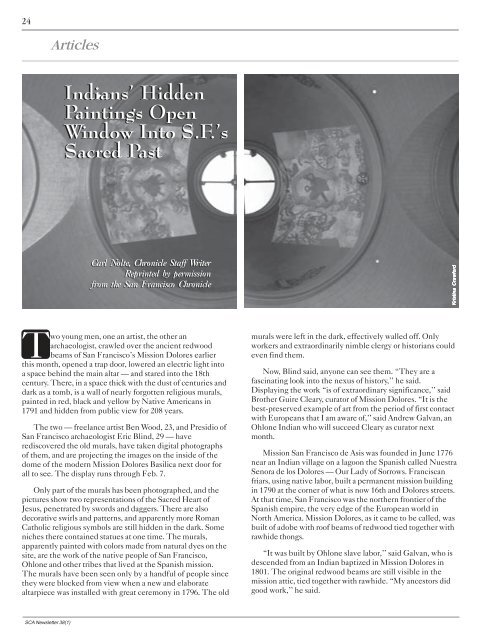March 2004 - Society for California Archaeology
March 2004 - Society for California Archaeology
March 2004 - Society for California Archaeology
Create successful ePaper yourself
Turn your PDF publications into a flip-book with our unique Google optimized e-Paper software.
24<br />
Articles<br />
Indians’ Hidden<br />
Paintings Open<br />
Window Into S.F.’s<br />
Sacred Past<br />
Carl Nolte, Chronicle Staff Writer<br />
Reprinted by permission<br />
from the San Francisco Chronicle<br />
Kristina Craw<strong>for</strong>d<br />
Two young men, one an artist, the other an<br />
archaeologist, crawled over the ancient redwood<br />
beams of San Francisco’s Mission Dolores earlier<br />
this month, opened a trap door, lowered an electric light into<br />
a space behind the main altar — and stared into the 18th<br />
century. There, in a space thick with the dust of centuries and<br />
dark as a tomb, is a wall of nearly <strong>for</strong>gotten religious murals,<br />
painted in red, black and yellow by Native Americans in<br />
1791 and hidden from public view <strong>for</strong> 208 years.<br />
The two — freelance artist Ben Wood, 23, and Presidio of<br />
San Francisco archaeologist Eric Blind, 29 — have<br />
rediscovered the old murals, have taken digital photographs<br />
of them, and are projecting the images on the inside of the<br />
dome of the modern Mission Dolores Basilica next door <strong>for</strong><br />
all to see. The display runs through Feb. 7.<br />
Only part of the murals has been photographed, and the<br />
pictures show two representations of the Sacred Heart of<br />
Jesus, penetrated by swords and daggers. There are also<br />
decorative swirls and patterns, and apparently more Roman<br />
Catholic religious symbols are still hidden in the dark. Some<br />
niches there contained statues at one time. The murals,<br />
apparently painted with colors made from natural dyes on the<br />
site, are the work of the native people of San Francisco,<br />
Ohlone and other tribes that lived at the Spanish mission.<br />
The murals have been seen only by a handful of people since<br />
they were blocked from view when a new and elaborate<br />
altarpiece was installed with great ceremony in 1796. The old<br />
murals were left in the dark, effectively walled off. Only<br />
workers and extraordinarily nimble clergy or historians could<br />
even find them.<br />
Now, Blind said, anyone can see them. “They are a<br />
fascinating look into the nexus of history,’’ he said.<br />
Displaying the work “is of extraordinary significance,’’ said<br />
Brother Guire Cleary, curator of Mission Dolores. “It is the<br />
best-preserved example of art from the period of first contact<br />
with Europeans that I am aware of,’’ said Andrew Galvan, an<br />
Ohlone Indian who will succeed Cleary as curator next<br />
month.<br />
Mission San Francisco de Asis was founded in June 1776<br />
near an Indian village on a lagoon the Spanish called Nuestra<br />
Senora de los Dolores — Our Lady of Sorrows. Franciscan<br />
friars, using native labor, built a permanent mission building<br />
in 1790 at the corner of what is now 16th and Dolores streets.<br />
At that time, San Francisco was the northern frontier of the<br />
Spanish empire, the very edge of the European world in<br />
North America. Mission Dolores, as it came to be called, was<br />
built of adobe with roof beams of redwood tied together with<br />
rawhide thongs.<br />
“It was built by Ohlone slave labor,’’ said Galvan, who is<br />
descended from an Indian baptized in Mission Dolores in<br />
1801. The original redwood beams are still visible in the<br />
mission attic, tied together with rawhide. “My ancestors did<br />
good work,’’ he said.<br />
SCA Newsletter 38(1)

















